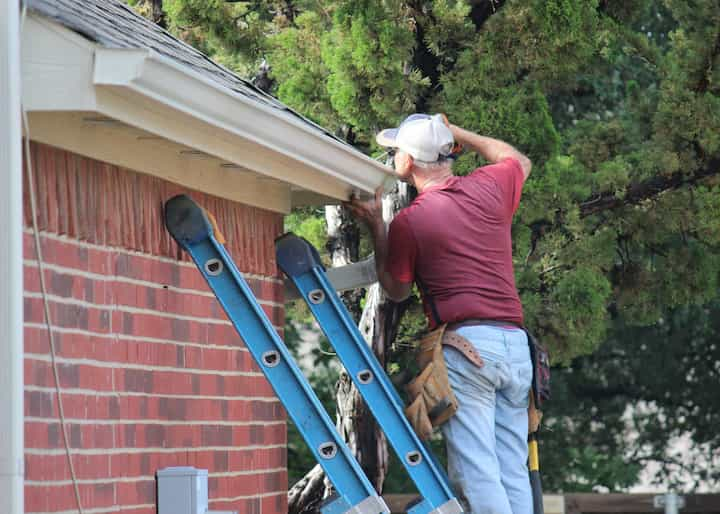
What are the most common types of emergency roof repairs?
Roof damage can be caused by a variety of factors, from severe weather conditions to normal wear and tear. When a roof is damaged, it can lead to water leaks, structural damage, and even collapse in extreme cases. Emergency roof repairs are crucial to prevent further damage and ensure the safety of building occupants.
Knowing the most common types of emergency roof repairs can help property owners and managers be prepared for potential issues.
Damage from severe weather conditions
Damage resulting from severe weather conditions is a common cause of emergency roof repairs. These weather conditions include strong winds, heavy rainfall, hailstorms, and snow buildup.
Strong winds can cause shingles to become loose or even blow off completely, exposing the underlying structure of the roof. Heavy rainfall can lead to leaks in the roof, which can cause water damage to the interior of the house. Hailstorms can also cause damage to shingles, leaving them cracked or dented. Finally, snow buildup can cause the roof to collapse under its weight, which can be a dangerous situation for the occupants of the house. It is important to address any damage resulting from severe weather conditions as soon as possible, as it can lead to more extensive damage if left unchecked. Emergency repairs can include replacing missing or damaged shingles, sealing leaks, and repairing any structural damage. In some cases, a complete roof replacement may be necessary.
Homeowners can take steps to prevent damage from severe weather conditions by ensuring that their roof is properly maintained and inspected regularly. This can include trimming nearby trees to prevent them from falling onto the roof during a storm and ensuring that gutters are clear to prevent water buildup.
Loose or damaged shingles
Loose or damaged shingles on a roof can greatly compromise its ability to protect a home from external elements, leaving homeowners vulnerable and uneasy during harsh weather conditions. Shingles are the outermost layer of a roof, and they are designed to protect the underlying layers from weather damage.
Loose or damaged shingles can expose the underlying layers of a roof to the elements, which can lead to water damage, leaks, and even structural damage if left unchecked. There are several reasons why shingles may become loose or damaged. High winds, heavy rain, and hail can all cause shingles to become dislodged or damaged.
Additionally, shingles may become damaged over time due to exposure to the sun's UV rays, which can cause them to become brittle and crack. Regular maintenance and inspection of a roof can help homeowners identify loose or damaged shingles before they become a bigger problem. In the event that shingles do become loose or damaged, it is important to have them repaired or replaced as soon as possible to prevent further damage to the roof and protect the home from the elements.
Roof leaks and their causes
Water infiltration through a roof can cause significant harm to a home, leading to the need for repairs and potential replacement. Roof leaks are a common type of emergency repair that homeowners face.
The causes of roof leaks can vary, but they often occur due to damage to the roof or poor installation. One of the most common causes of roof leaks is shoddy workmanship during installation. This can include improper sealing of seams, nails that are not properly spaced or driven, or flashing that is not installed correctly. Other causes of roof leaks include damage from severe weather, such as hail or wind, and damage from fallen branches or other debris. In order to prevent or mitigate damage from roof leaks, it is important to have your roof inspected regularly by a professional and to address any issues as soon as they arise.
Issues with flashing
Flashing, a thin but important material used to prevent water infiltration at critical points on a roof, can become ineffective over time due to exposure to weather and UV radiation. Flashing is typically made of metal, plastic, or rubber and is strategically placed around roof penetrations such as chimneys, vents, and skylights.
When flashing fails, water can seep into the roof, causing damage to the underlying structure and promoting the growth of mold and mildew. Common issues with flashing include cracks, splits, and rusting. These can be caused by a variety of factors, including normal wear and tear, improper installation, and exposure to harsh weather conditions. In some cases, flashing may simply need to be repaired or replaced. In other cases, the underlying issue may need to be addressed before new flashing is installed. Regardless of the cause, it is important to address flashing issues quickly to prevent further damage to the roof and underlying structure.
Faulty roof membrane
The integrity of a roof can be compromised by a faulty membrane, which acts as a protective layer over the roofing structure. This membrane is typically made of a rubber-like material, such as EPDM or TPO, and is installed to prevent water from seeping into the underlying roofing materials.
However, over time, the membrane can become damaged due to a variety of reasons, including weather-related wear and tear, excessive foot traffic, or poor installation. A faulty roof membrane can lead to a range of structural issues and potential safety hazards. For instance, if water is able to penetrate the roofing materials, it can cause damage to the structure of a building, leading to rot, mold, and mildew growth.
Moreover, if the membrane is damaged in a way that allows water to enter the building, there is a risk of electrical hazards and potential fire hazards. Therefore, it is important to address any issues with a faulty roof membrane as soon as possible to prevent further damage and ensure the safety of building occupants. If you're looking for emergency roof repair contractors that can restore or replace your roof with professional service and quality materials, we've got your covered. Get in touch with our experts today.